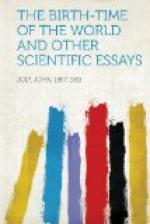[1] The law of Least Action, which has been applied, not alone in optics, but in many mechanical systems, appears physically based upon the restraint and retardation opposing the transfer of energy in material systems.
66
GENERAL DYNAMIC CONDITIONS ATTENDING ANIMATE ACTIONS
What is the actual dynamic attitude of the primary organic engine—the vegetable organism? We consider, here, in the first place, not intervening, but resulting phenomena.
The young leaf exposed to solar radiation is small at first, and the quantity of radiant energy it receives in unit of time cannot exceed that which falls upon its surface. But what is the effect of this energy? Not to produce a retardative reaction, but an accelerative response: for, in the enlarging of the leaf by growth, the plant opens for itself new channels of supply.
If we refer to “the living protoplasm which, with its unknown molecular arrangement, is the only absolute test of the cell and of the organism in general,[1] we find a similar attitude towards external sources of available energy. In the act of growth increased rate of assimilation is involved, so that there is an acceleration of change till a bulk of maximum activity is attained. The surface, finally, becomes too small for the absorption of energy adequate to sustain further increase of mass (Spencer[2]), and the acceleration ceases. The waste going on in the central parts is then just balanced by the renewal at the surface. By division, by spreading of the mass, by
[1] Claus, Zoology, p. 13.
[2] Geddes and Thomson, The Evolution of Sex, p. 220.
67
out-flowing processes, the normal activity of growth may be restored. Till this moment nothing would be gained by any of these changes. One or other of them is now conducive to progressive absorption of energy by the organism, and one or other occurs, most generally the best of them, subdivision. Two units now exist; the total mass immediately on division is unaltered, but paths for the more abundant absorption of energy are laid open.
The encystment of the protoplasm (occurring under conditions upon which naturalists do not seem agreed[1]) is to all appearance protective from an unfavourable environment, but it is often a period of internal change as well, resulting in a segregation within the mass of numerous small units, followed by a breakup of the whole into these units. It is thus an extension of the basis of supply, and in an impoverished medium, where unit of surface is less active, is evidently the best means of preserving a condition of progress.
Thus, in the organism which forms the basis of all modes of life, a definite law of action is obeyed under various circumstances of reaction with the available energy of its environment.
Similarly, in the case of the more complex leaf, we see, not only in the phenomenon of growth, but in its extension in a flattened form, and in the orientation of greatest surface towards the source of energy, an attitude towards




